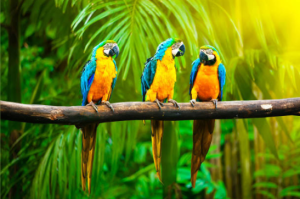Parrot Body Language Signs and Interpretation
Parrots are brilliant social creatures, and their body language is a complex way to communicate with each other and humans. By reading your parrot’s body language, you can better understand their needs and feelings and build a stronger bond.
Here are some of the most common parrot body language signs and their interpretations:
Eyes
- Dilated pupils: Dilated pupils can indicate excitement, fear, or aggression.
- Constricted pupils: Constricted pupils can indicate boredom, contentment, or illness.
- Eye pinning: Eye pinning is a behavior where a parrot will stare directly at another bird or person with a fixed gaze. This can be a sign of aggression, dominance, or courtship.
- Eye closing: Eye closing can signify relaxation, contentment, or sleepiness.
Beak
- Beak grinding: Beak grinding is an expected behavior in parrots, and it can be a sign of contentment, boredom, or stress.
- Beak clicking: Beak clicking is a behavior that is most common in cockatoos, and it can be a sign of excitement, aggression, or annoyance.
- Beak snapping: Beak snapping is a warning sign that a parrot is about to bite.
Feathers
- Fluffed feathers: Fluffed feathers can signify excitement, fear, or aggression.
- Sleek feathers: Sleek feathers are a sign of relaxation or contentment.
- Feathers raised on the back of the neck are a sign of aggression or dominance.
- Feathers plucked out: Plucking feathers out can signify stress, boredom, or illness.
Wings
- Wings spread wide: This can signify aggression, excitement, or playfulness.
- Wings held close to the body can be a sign of fear, submission, or contentment.
- Wings flapping: This can signify excitement, anxiety, or aggression.
Tail
- Tail held high: This can signify excitement, dominance, or aggression.
- Tail kept low: This can indicate fear, submission, or contentment.
- Tail bobbing: This can convey excitement, playfulness, or attack.
Body posture
- Standing up straight can be a sign of alertness, excitement, or dominance.
- Crouching down can be a sign of fear, submission, or aggression.
- Lying down: This can be a sign of relaxation or contentment.
Other signs
- Regurgitation: Regurgitation is a behavior where a parrot will regurgitate food and offer it to another bird or person. This can be a sign of affection, courtship, or submission.
- Dancing: Dancing is a behavior that is most common in cockatoos, and it can be a sign of excitement, playfulness, or courtship.
- Talking: Talking is a most common behavior in African Grey parrots, and it can be a way for them to communicate with their owners.
It is important to note that parrot body language can be complex and nuanced, and there is no single interpretation for every sign. The best way to understand your parrot’s body language is to pay attention to their overall behavior and consider the context in which they display the character.
Tips for interpreting your parrot’s body language
- Look at the whole picture. Consider all of the signs that your parrot is displaying and the context in which they are showing them. For example, a parrot with fluffed feathers and a raised tail may be excited if they are about to get a treat, but they may also be aggressive if they feel threatened.
- Pay attention to your parrot’s facial expressions. Parrots have very expressive faces, and their eyes and beaks can tell you a lot about how they are feeling. For example, a parrot with dilated pupils and a hooked beak may be about to bite.
- Consider your parrot’s personality. Every parrot is different, and some parrots are more expressive than others. If you are new to parrot ownership, learning to read your parrot’s body language may take some time.
If you are unsure how to interpret your parrot’s body language, it is always best to err on the side of caution and assume they are feeling threatened or aggressive. It is also essential to teach your children and other visitors to your home how to read parrot body language.



